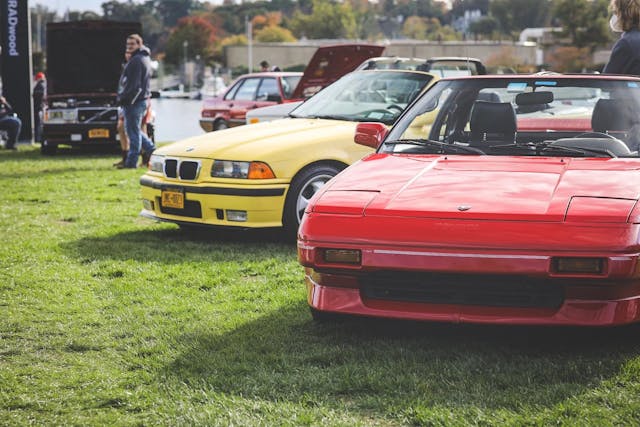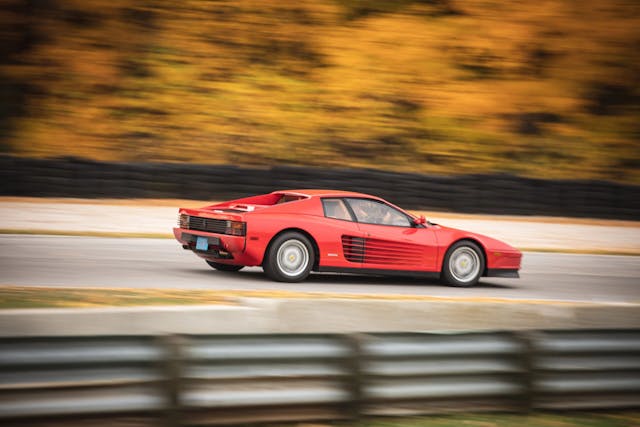Media | Articles
It’s different now: Why fast-rising collector cars aren’t headed for a crash
“It was a bloodbath. Dealers were taking anything they could to clear out their stock. Some cars were changing hands for a tenth of what they’d sold for the previous year.”
There aren’t many dealers who can remember what it was like back in the 1990s when the classic car market crashed, but Martin Chisholm of the Classic Motor Hub is one. As a young man at the time, relatively new in the London collector car business, it was a lesson that hit home hard and made an indelible imprint on him for many years to come.
It may seem odd—and unnecessarily gloomy—to flash back to the darkest moment in our industry at a time when classic car values are soaring. Our latest Hagerty Price Guide, published earlier this month, shows widespread gains, and our Market Rating is at a record high of 78.22. Looking ahead, we are anticipating one of the finest crops of collector cars we’ve ever seen will be on offer during Monterey Car Week. The good times are still rolling.
Yet it is the very height to which the market has risen that has some experts pondering what a fall might look like. “I see corners of today’s market that are reaching fever-pitch, and there is always cause for concern when rapid appreciation happens within in a short period of time…” says U.S.-based dealer Mark Hyman, another industry veteran who remembers firsthand the doldrums of the early ’90s. “Whenever there is hyper-activity, values can shoot to a level that may not be sustainable over the long term.”
Not long ago, Hagerty wrote about the bubble and subsequent crash in collector car values during the 1980s and early 1990s. The natural question that arises is, Can it happen again?
The good times are still rolling. Yet it is the very height to which the market has risen that has some experts pondering what a fall might look like.
There’s no doubt that values simply cannot continue to increase at the rate they have been. In the past year alone, average UK Hagerty Price Guide values of the Jaguar XJ220 have risen by 14.6 percent, the Porsche 959 Komfort by 15.2 percent, and the Bugatti EB110 by an astonishing 32.9 percent. Other, gold-standard classics have risen too: Hagerty’s average value for the Mercedes-Benz 300SL Gullwing has grown by 28.5 percent in the past year (note that the average value for a Gullwing is not the same as our 300SL repeat sale index). Much of this growth owes to long-term demographic trends—namely the fact that Gen–Xers are now entering their peak collecting years. Huge shifts within the auto industry will also feed interest: as new cars become increasingly tech forward and removed from drivers, it’s reasonable to expect enthusiasts of all stripes will continue flocking to “analog” classics.
Yet there are factors that echo the dark days leading up to the 1990s crash. Inflation is soaring and everywhere you look, from art and watches to property and handbags, records are being broken as people with money try to convert their cash into assets.
There are warning signs lower in the market, too. At the sub-$50,000 enthusiast level, Hagerty watched a surge in values almost across the board after the first COVID lockdowns as people who had always wanted a classic and had saved some money during the pandemic went ahead and took the plunge, suddenly more aware than ever of their own mortality. Now, with the cost of living (and gas) soaring, many of these purchases are starting to seem like luxuries that can no longer be justified. Just last weekend at the Leamington Spa Classic Car Auctions sale, Hagerty recorded 49 of the 195 cars being offered at no reserve, a full 25 percent of the catalog. At the moment, there are enough buyers ready to pick up bargains, but what if the squeeze hits them too?
The problem with cars as an asset class is one of the main reasons they are attractive: They are easy to buy and sell. If you want to purchase a £4M house in London, you have to view, offer, have the offer accepted, go to a solicitor to conduct searches and process the contract, and commission a surveyor to inspect the building. If you’re borrowing money, the lender will also separately value the property. Even if you’re buying with cash, you can expect the whole process to take at least a couple of months. But if you want a £4M classic car, you can simply visit a showroom, transfer the money, sign some paperwork, and drive away in it. That’s great if everything continues as planned, but if life throws a curve ball and you suddenly need money, it’s the car rather than the house that provides the quickest route to liquidity. And, if the reason you’re selling affects others, too, then the market can become swamped.
But if there are similarities to the 1990s, there are also important differences.
First and foremost, the ecosystem of car collectors has grown much bigger and more diverse over the decades. These people vastly outnumber the speculators who will dump their cars the moment the returns don’t make sense on a spreadsheet. “I think there is really a lot more passion now,” leading dealer Max Girardo told me. Just as important, Girardo adds, there is much more to do with classic cars than there was back in the 1980s, from vintage motorsports to Facebook groups. “…The events and the lifestyle…does make a difference to the market. There is a much bigger community now, look at social media, cars and coffee, the list goes on and on.”

Back in 1990s, the wolves of Wall Street just wanted cars that went up in value. Ferraris made the most money, so it was Ferraris they bought. Some of them didn’t even drive them. Back then, car club meets were in the back rooms of smokey pubs, rallies a gentle jaunt through the countryside. Now, we have Radwood, Luftgekhult, and the Goodwood Festival of Speed, thriving online groups and a whole lot of passionate people. This passion is encouraged by those in the trade who understand why it is important and can remember the first crash, as Hyman told me. “Historically, collector vehicles have proven over to be sound long-term investments. But like I always tell my clients, investment shouldn’t be your primary motivation to buy a collector vehicle—buy what you love, something you’ll enjoy, and treat it as a valuable asset.”
Collectors not only care more these days—they know more, too. Back in 1990, if you wanted to buy a collectable car maybe you read a magazine or two, spoke to your mates, and then went and had a look at it. Today, thanks largely to the internet, any enthusiast can quickly connect to marque and model experts and browse “comps” sold at auctions to make sure that they’re not paying over the odds. We can’t help but point out that resources like the Hagerty Price Guide and the website you’re reading play an important role, as well. “It’s not isolated enthusiasts buying any more,” said Rob Johnson from Classic & Sports Finance. “It’s a whole lifestyle.”
Another key difference is that people interested in a quick buck now have more tempting targets than cars. Remember: back in 1990 even standard stock investments had to be managed by a stockbroker and sold following an exchange of letters. Today, stocks—not to mention cryptocurrencies—can be cashed in through an app and back in your bank within hours. Among tangible assets, cars have always been tougher to move than art, but now trail watches and sneakers, too. It’s much more likely an owner will shift those first back into cash rather than the shiny Porsche 930 or Ferrari F40 they have lusted after since their teens and that, in any event, is much harder to get rid of in a hurry.
Back in the 1980s, lots of collectors weren’t, in fact, collecting cars but rather were borrowing them, and at dangerously high interest rates.
Perhaps the most important of the differences are in the nitty gritty details of financing. Back in the 1980s, lots of car collectors weren’t collecting with their own money—they were borrowing at very high interest rates. “There were a handful of lenders generally providing for a few genteel buyers who were more like antiques dealers than car traders,” remembers Johnson. “Lots of deals were done in the old-fashioned London way over lunch; it was actually quite easy to get money and there wasn’t a lot of detailed underwriting going on, as there wasn’t the awareness of possible fraud that there is now. They were lending on everything, and at massive rates—20 percent APR wasn’t unusual—and the market just couldn’t sustain it. When the crash came, all of this came out of the woodwork.” When car values started to dip, over-leveraged collectors found themselves compelled to sell to try to make good with lenders, which flooded the market and drove down values further still.
After that, things changed. The 1990s saw the market for classics calm again and some lending regulation, but it was the sub-prime mortgage collapse of 2008 that made rules really tighten. “From about 2005 to 2008, we started to lend on some very valuable cars but when the global financial crisis hit, all this dried up. Banks suddenly didn’t want to lend, and many countries realized they needed tighter rules in place. The lending market almost closed down for a while as a result.”
Within a few years, more conservative lending practices were cemented into law: In the U.S. the Dodd-Frank Wall Street Reform and Consumer Protection Act was passed in 2010 and in the UK the Financial Conduct Authority (FCA) was created in 2013, with strict rules regulating the conduct of over 51,000 financial businesses. In the EU, the European Banking Authority was established in 2011 to the same end: to create a single set of harmonized prudential rules for financial institutions.
Today, these and other worldwide boards oversee the lending market and hopefully ensure that lending against anything—cars included—is done in a sensible way. That helps explain why the collector car market corrected but didn’t crash, after peaking in 2014. Sellers who didn’t get offers they expected simply shrugged and took their cars back home. Few had to sell, and that stabilized values.
So, are we due a correction now, or even a crash? I could be writing my famous last words, but I think not. Obviously, some areas of the market will drop. Others will remain static and won’t keep up with inflation. But given the state of the major world economies at the moment—which have already weathered the pandemic, recession, inflation, war in Europe, and huge levels of uncertainty—there is still an astonishing amount of money out there, ready to buy. That, I predict, won’t change soon.
Even if I’m wrong, and values across the board decline, the market will endure. We are in a very different place to the late 1980s and early 1990s. It is a more complex place, with buyers and sellers swapping cars in ways unimaginable decades ago, but it is on the whole a more stable place and a better one too, thanks to knowledgable collectors who are here for the joy and not the returns. As Hyman told me, “As long as enthusiasts drive the market, we’re unlikely to see a repeat of the 1990s bursting bubble.”
***
Marketplace
Buy and sell classics with confidence
Check out the Hagerty Media homepage so you don’t miss a single story, or better yet, bookmark it. To get our best stories delivered right to your inbox, subscribe to our newsletters.



